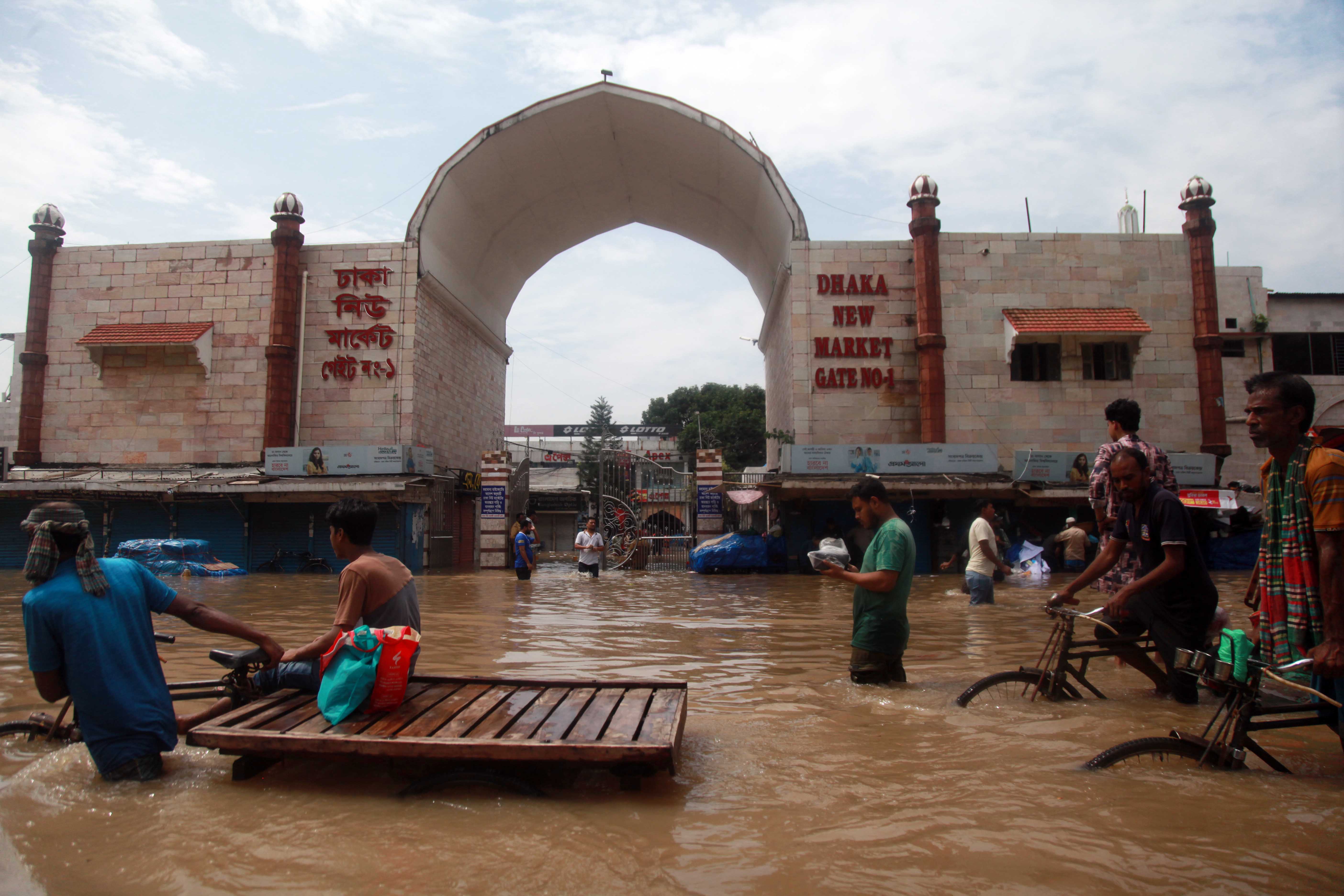
Heavy downpour on Friday submerged most roads in Dhaka, photo credit: Nazmul Islam
Dhaka residents were awakened by a heavy monsoon downpour on Friday morning that lasted over three hours and submerged numerous roads and alleys.
The intense rainfall delivered over a third of the city's typical July rainfall in just six hours and had led to widespread waterlogging, a recurring issue for the city.
Although unusually heavy rain can worsen waterlogging in Dhaka, the city's flooding issues are not solely dependent on such weather events.
Weather, more precisely climate change, has played its role as meteorologists and experts have noted a shift in Bangladesh's monsoon rainfall patterns, characterized by fewer rainy days and shorter, more intense downpours.

While the total rainfall amount remains relatively unchanged, climate change is believed to be contributing to this trend, leading to an increase in extreme weather events such as prolonged heatwaves and heavier rainfall bursts.
However, waterlogging is a persistent problem in the capital, largely attributed to mismanagement rather than natural causes.
Over the past four years, the two city corporations of Dhaka have spent at least 730 crore taka to resolve water logging issues. However, yesterday three-hour rainfall showed how effective these efforts have been.
These monsoon rains, a welcome relief after the scorching summer heat, quickly become a bane for Dhaka's residents due to the city's inadequate drainage system. Heavy downpours inundate roads and streets with murky water, disrupting the already chaotic traffic.

Experts have long been saying that this waterlogging is a result of several interconnected factors.
Limited infrastructure, the inability of authorities and contractors to establish functional sewage systems, and the lack of awareness among citizens who unknowingly contribute to clogging the drainage network–all play their parts.
In paper, Dhaka boasts an extensive drainage system, with 370 km of storm sewers and 2,840 km of surface drains managed by Dhaka WASA, and over 2,000 km of feeder drains maintained by the two city corporations.
However, these figures are dwarfed by the challenges posed by the city's massive population of two million, its daily waste generation of 7,000 tons, and an average annual rainfall of 1,900 mm.

The core problem
Dr. Quazi Azizul Mawla, a BUET architecture professor with extensive research on Dhaka's sewage system, emphasizes that the reason for Dhaka's monsoon flooding is straightforward.
He explains, "Rainwater needs to flow out of the city to a lower elevation through a functional, well-maintained drainage network. In a properly designed system, rainwater would quickly drain into designated retention areas."
Prof. Mawla asserted that stagnant rainwater indicates either an insufficient or inefficient drainage system, and Dhaka suffers from both.
He said that Dhaka needs at least 20 retention ponds the size of Hatirjheel to manage stormwater effectively. Unfortunately, there's only one Hatirjheel in the city.
He further explains that Dhaka's storm water drains, designed long ago, are inadequate for the current volume of rainwater.

Originally planned in the early 20th century, the system assumed a maximum rainfall of 25 mm per hour with half being absorbed by the soil.
However, rapid urbanization has led to widespread paving and concreting, drastically reducing the ground's absorption capacity.
Consequently, even with moderate rainfall, the drainage system is overwhelmed, struggling to handle twice its intended capacity.
Furthermore, Dhaka WASA, responsible for the storm water sewage system, can only handle 20 mm of rainfall per hour. Rainfall exceeding 30mm would take at least two hours to drain, exacerbating the waterlogging problem.
The problem is, WASA and other relevant authorities tend to deflect responsibility and lack coordination in addressing this issue.

Pillow-passing of responsibility
During this government's previous term, a 23-year sewerage master plan worth US$2 billion was developed to improve the city's infrastructure.
However, while the first phase of this plan has been implemented over a seven-year period, the second phase is still going at a snail's pace.
Kamrul Hasan Chowdhury, Chief Engineer of WASA, stated that the project work under the master plan is ongoing.

“It's important to understand that we are responsible for the drainage of only 39% of the capital. In the areas under our purview, we carry out maintenance work every year,” he told Bangla Outlook.
He also pointed out that drain desilting is typically done once before the monsoon.
"We would like to perform desilting throughout the year, but the budget for this is only allocated in April-May," he added.
Meanwhile, construction debris left unattended near drains is further exacerbating the drainage issues in Dhaka.

Khairul Alam, CEO of Dhaka North City Corporation (DNCC) told Bangla Outlook that many construction projects, meant to increase transportation facilities in the city, are ironically contributing to the deterioration of its drainage system.
Alam said, Rajdhani Unnayan Kortipokkho is responsible for managing construction debris and preventing it from clogging drains.
“We only maintain feeder drains, this alone won't solve Dhaka's waterlogging crisis,” he said, adding that the reclamation of Dhaka's 22 canals from illegal occupants is crucial.
“These water bodies are essential for discharging rainwater, even with a developed sewerage network,” he added.
—--

